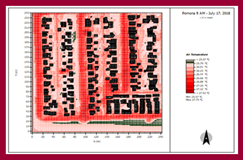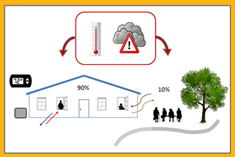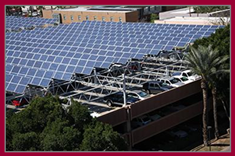David Sailor’s Research Group
Dr. Sailor is a Professor in the School of Geographical Sciences and Urban Planning (SGSUP) at ASU, and also the Director of the Urban Climate Research Center (visit UCRC site). He also holds an appointment on the Graduate Faculty of the School of Sustainable Engineering and the Built Environment (SSEBE). The following three topic areas are reflective of current research in his group.

Targeted mitigation of urban heat
Vulnerability is the intersection of exposure, sensitivity, and adaptive capacity. In the context of excess urban heat, exposure refers to locations within a city that are particularly hot and/or humid. The most sensitive populations are the elderly, the very young, and those with pre-existing conditions. The sub-populations that lack adaptive capacity include those in poverty, for whom the purchase/maintenance/repair of air conditioning systems is a challenge, and also populations that have limited social networks. We use modeling across scales (building-neighborhood-city) to explore heat mitigation technologies and strategies.

Buildings and indoor/outdoor exchange processes
Urban residents spend ~85% of their time indoors. So, while outdoor urban climates are key influencers of indoor environments, it is important to understand how design, construction, and management of buildings influences this relationship and the relative importance of indoor/outdoor sources of heat and pollutants. We explore factors such as building materials, the use of windows, air exchange rates into indoor spaces, and the use of innovative materials. We get at these relationships using field measurements in buildings and also through validated buildng modeling.

Unintended co-benefits and adverse consequences of urban sustainability measures
Environmental challenges and solutions interact. For example, strategies to cool the urban environment may also impact air quality, energy use, storm water runoff, etc. It is therefore misleading to evaluate any sustainability strategy without accounting for these complex and myriad interactions. Our research in this area uses measurements and modeling to conduct more comprehensive analyses of prospective solutions. Our recent focus has been on unintented consequences related to urban photovoltaics, high solar-reflectance surfaces, and urban vegetation.
Representative Sample of our publications:
- Brown, K.E., A. Baniassadi, J.V. Pham, D.J. Sailor, and P.E. Phelan, 2020. “Effects of rooftop photovoltaics on building cooling demand and sensible heat flux into the environment for an installation on a white roof,” ASME Journal of Engineering for Sustainable Buildings and Cities, 1, 021001-2. https://doi.org/10.1115/1.4046399
- Pham, J.V., A. Baniassadi, K.E. Brown, J. Heusinger, and D.J. Sailor, 2019. Comparing photovoltaic and reflective shade surfaces in the urban environment: effects on surface sensible heat flux and pedestrian thermal comfort. Urban Climate, 29,100500. https://doi.org/10.1016/j.uclim.2019.100500
- Baniassadi, A., D.J. Sailor, and G. Ban-Weiss, 2019. Potential energy and climate benefits of super-cool materials as a rooftop strategy, Urban Climate, 29 100495. https://doi.org/10.1016/j.uclim.2019.100495
- Sailor, D.J., A. Baniassadi, C.R. O’Lenick, O.V. Wilhelmi, 2019. The growing threat of heat disasters. Environmental Research Letters, available online. https://doi.org/10.1088/1748-9326/ab0bb9
- Crank, P.J., D.J. Sailor, G. Ban-Weiss, and M. Taleghani, 2018. “Evaluating the ENVI-met microscale model for suitability in analysis of targeted urban heat mitigation strategies”, Urban Climate, 26, 188-197.
- Baniassadi, A., D.J. Sailor, P.J. Crank, and G.A. Ban-Weiss, 2018. “Direct and indirect effects of high-albedo roofs on energy consumption and thermal comfort of residential buildings,” Energy and Buildings, 178 (1) 71-83.
- Baniassadi, A., and D.J. Sailor, 2018. “Energy efficiency vs resiliency to extreme heat and power outages: The role of evolving building energy codes”, Building and Environment, 139, 96-94.
- Sailor, D.J., Shepherd, M., Sheridan, S., Stone, B., Kalkstein, L., Russell, A., Vargo, J., and Andersen, T., 2016. “Improving Heat-Related Health Outcomes in an Urban Environment with Science-based Policy, Sustainability”, 8 (10), 1-13, doi:10.3390/su8101015.
Interested in joining the group?
One unique feature of Dr. Sailor’s group is its highly interdisciplinary nature. At any given time the group includes undergraduate students working on honors research projects in collaboration with graduate students drawn from the School of Geographical Sciences and Urban Planning as well as from the School of Sustainable Engineering and the Built Environment. The group is further enriched by our work together with postdocs and visiting scientists. Contact Dr. Sailor directly for more information on current opportunities (dsailor@asu.edu).
More Information on Dr. Sailor
See ASU’s iSearch Database for more information on Dr. Sailor, including Bio and CV.

